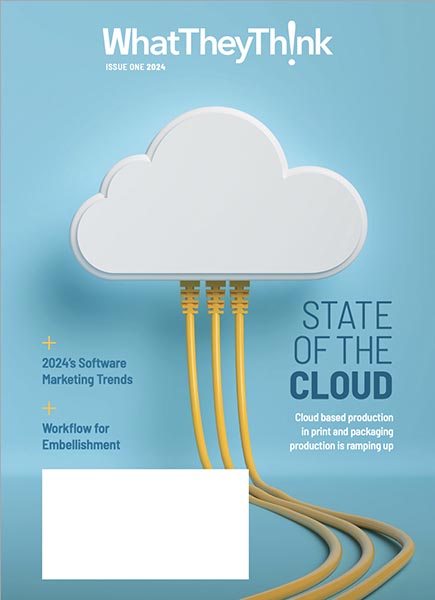One issue that was barely on the radar as recently as 2022 but which exploded into the zeitgeist in 2023 is so-called “artificial intelligence” (AI), insinuating itself into virtually every aspect of society. Naturally, it is also impacting the printing industry in a variety of ways. This week, we’ll look at a few aspects of AI and its potential uses for print businesses. We will also be looking at the current state of “the cloud”—that “big, fluffy ghost that lives in our networks,” per Pat McGrew.

We kick the week off with David Zwang’s overview of the current state of cloud software for the industry and how machine learning—a topic closely related to, and often confused with, artificial intelligence—is integrating with cloud software. Pat McGrew explains “Zero Trust” workflows—the modern approach to cloud-enabled workflow architecture—and how the changing legislative and technology landscapes demand a new approach to securing a print shop. Contributor Jim Russell from New Direction Partners explains how a company’s technology infrastructure is an important consideration for a potential buyer—so if you are thinking of selling your business, an upgrade may be in order.
On Tuesday, Pat McGrew and Ryan McAbee look at how the cloud is transforming virtually every aspect of the print business in shops of all sizes. Patrick Henry looks at software-driven workflows for offset production. We present our Executive Q&A with Patrick Keller of Baldwin Technology, the sponsor of this issue. In other topics, Cary Sherburne looks at some new developments in textiles, including Mimaki’s new Neo Chromato Process that removes ink dye-sublimated onto textiles, resulting in a white textile that can then be reprinted or more easily recycled. Cary also looks at the latest news involving her favorite material—graphene—and how it is being used to remove toxic dyes from wastewater.
On Wednesday, two case studies. Heidi Tolliver-Walker looks at how one particular print business—Atlanta’s Wise—got the most out of a print MIS implementation by developing a process for doing so and walks us through that process. And Cary Sherburne explores how Walker360 completely restructured its production platform, and realized exponential productivity gains. Pat McGrew and Ryan McAbee look at professional services, whether print businesses should offer them, and how partnering with professional services providers can elevate your print business to new heights of efficiency, innovation, and growth. On the marketing side, Joanne Gore looks at the wide variety of uses for AI for marketers, and how AI can be integrated with traditional marketing channels.
On Thursday, Kevin Abergel and Carlo Ruas look at revolutionizing your workflow for digital print embellishments. Cary Sherburne documents some potential AI use cases, talking with Nick Benkovich, Vice President of Product Management for eProductivity Software, about how a leading software provider for the industry is approaching AI. She also spoke with Frank Pennisi, EFI’s CEO, to gain insight into some of the ways a supplier to the industry might benefit from AI—which ultimately would benefit their customers. David Zwang looks at “rules-based workflows,” and provides some options for connecting and automating processes to fit your business needs. Cary also takes a look at the negative environmental impacts of “glitter”—call her Cary Glitter.
Finally, on Friday, the “Tales from the Database” series draws on our extensive Print Outlook Survey database to look at the extent to which print businesses have seen cloud computing as a challenge, an opportunity, and a planned investment. And over in Johnson’s World, Steve looks at how a flooring materials supplier has been using AI to craft its marketing and engage with customers.
That’s our Software Issue. Welcome!















Discussion
Only verified members can comment.